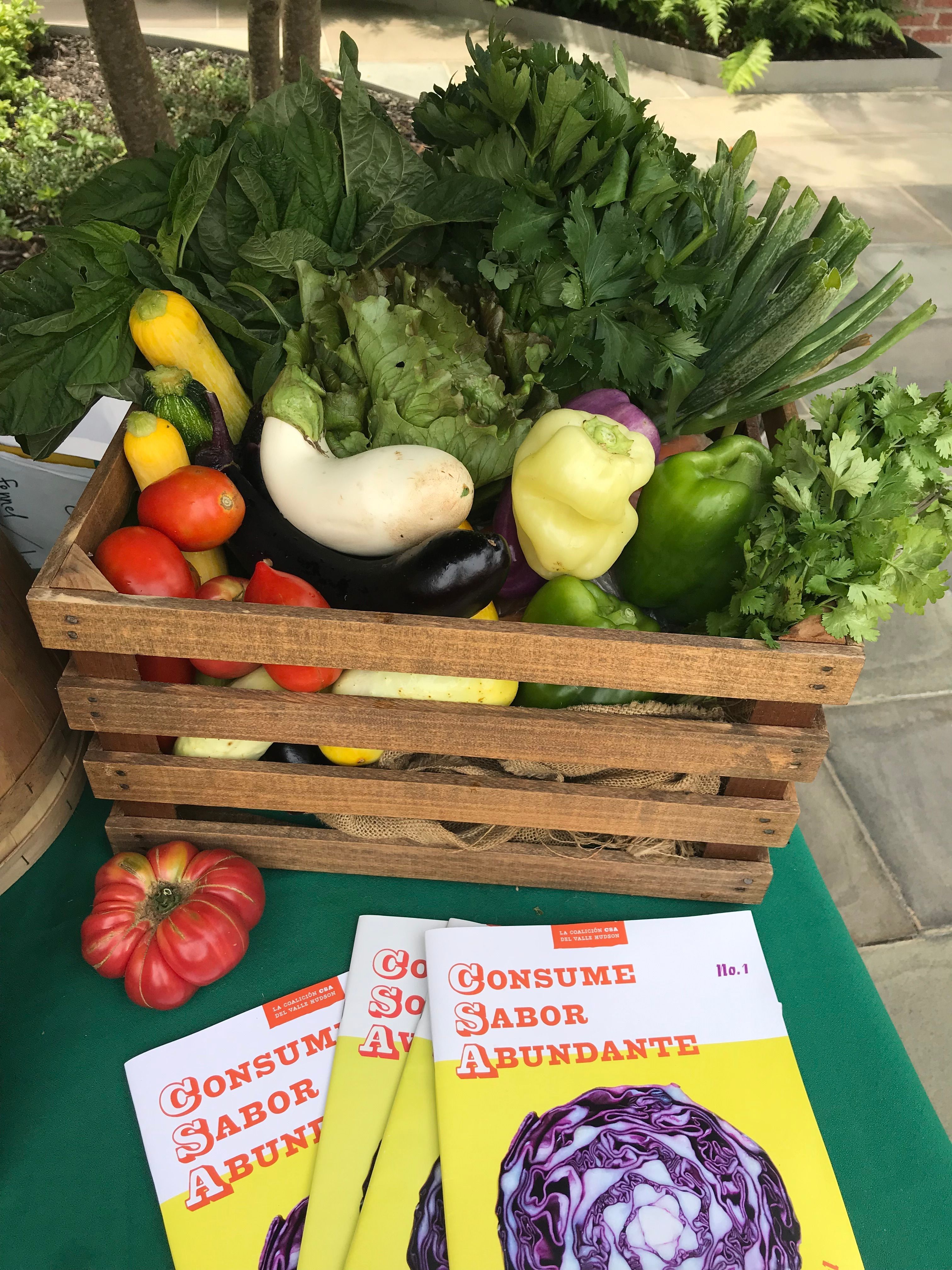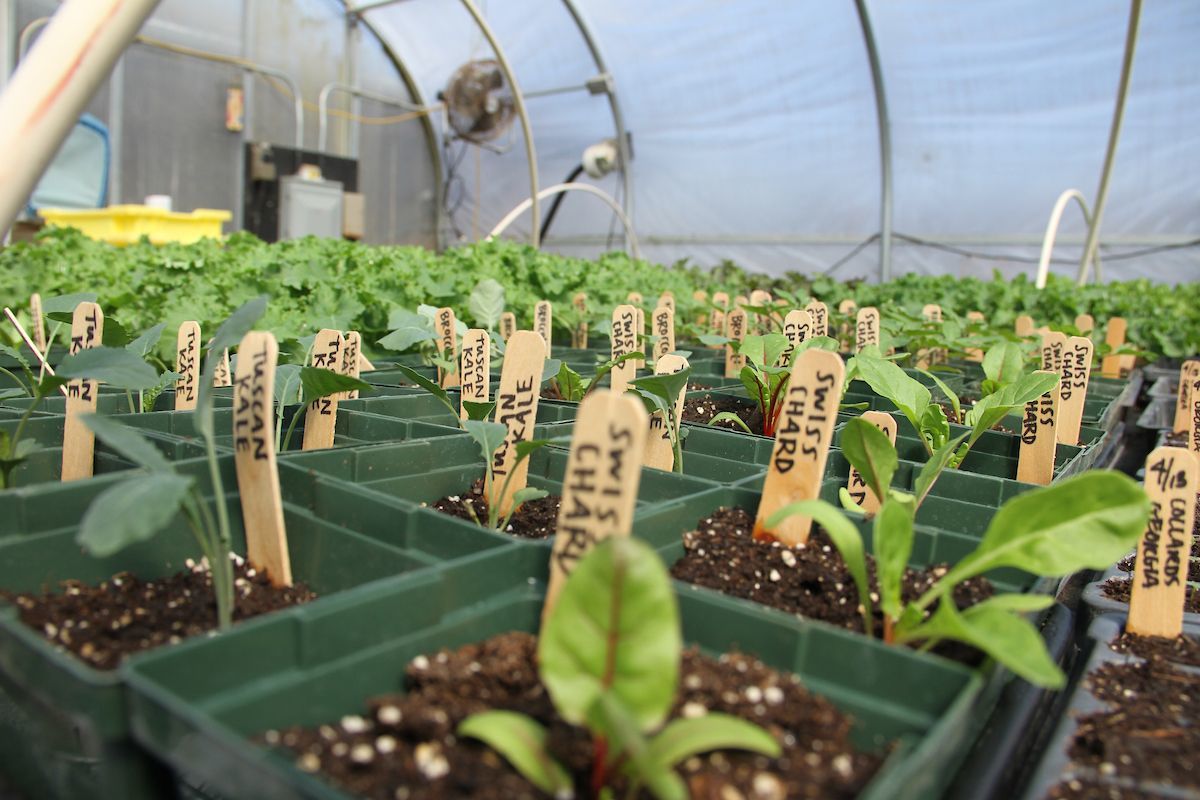
This blog originally appearing in the e-newsletter of the Gretchen Swanson Center for Nutrition
The Glynwood Center for Regional Food and Farming organizes the Hudson Valley CSA Coalition, a coalition of over 100 farms using the Community Supported Agriculture model in New York’s Hudson Valley. Coalition farms have long looked for a way to better serve low-income households, and “CSA is a SNAP” was developed to answer that request. “CSA is a SNAP” is a pilot project that has established a revolving loan fund to purchase CSA shares before the growing season so that farms can sell those shares on a payment plan, at subsidized rates, to SNAP users throughout the season. Those SNAP dollars will be used to recapitalize the fund which will be augmented through other fundraising. There are five farms in the pilot this season. Some are signing up members who use SNAP for a full season share while others are selling boxes on a first-come-first-served basis. Pictured is a share with Spanish language educational magazines.
What are you seeing firsthand in your communities regarding food insecurity during COVID-19?
We have seen a massive rise in the demand for emergency feeding programs in the Hudson Valley. Estimates from food pantries that we work with are along the lines of a four-fold increase. Simultaneously, the demand for CSA shares from households with means has also skyrocketed alongside demand for locally grown food at retail value generally; this has had the unintended consequence of limiting the availability of locally grown food for donation and gleaning. For this reason, we believe the “CSA is a SNAP” is even more critical to ensuring access to nutrient dense, locally grown food for low-income households in the region.
What unique challenges have you had to face?
Our plan for “CSA is a SNAP” was formulated in 2019, and we built relationships with community partners and farmers based on the landscape as it was then. Obviously, COVID-19 has profoundly altered all elements of our society, and this has raised serious challenges for the program. First, the majority of our “CSA is a SNAP” distribution sites are through partnerships with community health centers that would normally have a high volume of walk-in traffic that we were relying upon to raise awareness of the program and bring customers through. As these health centers were temporarily closed and drastically limited the number of patients they were seeing once they opened, we have had a tough time reaching SNAP users to make them aware of this program which has resulted in far fewer sales of CSA vegetable shares than we had estimated. Additionally, farms and community partners had to rethink every element of their operations from March 15, when New York state went into lockdown, forward. This has meant that they have had limited capacity to enact this pilot program and to strategize around how to adjust it during the pandemic. We have had support in meeting this challenge through funding provided by the Nutrition Incentive Hub Innovation Fund to allow for additional promotion through direct mailings and to cover the added expenses of increased farm and community partner labor and personal protective equipment purchase. We are optimistic that awareness and execution are improving each week and that we will see stronger sales for “CSA is a SNAP” produce shares as the growing season continues.
What does the process for redeeming SNAP through Community Supported Agriculture (CSA) look like?
The five pilot farms have adopted two primary models for accepting SNAP payment for produce shares. The first is on a first-come-first-served basis wherein the farm sets up share distribution (either at a health center or a farmers market) and makes produce shares available at a 30% discounted rate for one-time purchase. The second is a more traditional CSA model wherein a CSA member commits to the whole season and picks up their produce share on a weekly basis. These CSA members also receive a 30% discount for using their SNAP benefits and utilize a payment plan that allows them to pay every other week with their SNAP benefits.
Describe some of the benefits of challenges of CSA serving SNAP customers.
A benefit of serving SNAP customers is that CSA farmers are better able to feed their entire community, and not only those with higher incomes. A challenge is that the CSA model has best served middle-class households who are able to commit money before the season begins and have the transportation and scheduling flexibility to pick up their shares at the farm. In addition to these known barriers to low-income households utilizing CSA, there is implicit bias within the local farming community that puts unintentional barriers in place for many members of our community. To address the former, farms in this pilot have set up distribution sites that are intended to be more accessible in time slot and location. To address the later, GusNIP funds were utilized to host a training workshop for CSA farms to address implicit bias by doing things like planning to grow crops that are more familiar and culturally appropriate to people from historically marginalized demographics and by addressing language barriers. The “CSA is a SNAP” project has also made all relevant materials (promotion, website, educational materials) available in both English and Spanish in order to reach a broader audience of SNAP users.
What do you want others to know about becoming a SNAP-authorized farm?
The process is challenging for small farms that are low on administrative time, and guidance is not as clear as it could be. One lesson we have learned from this pilot year is that the budget for a coordinated process like this one must include funding to purchase SNAP processing equipment as the software to do so can be pretty finicky about what device it will run on and an expenditure of $200 for a new phone or tablet is prohibitive for small farms working with narrow margins.
If the pilot is successful, what are your plans for scaling the project?
If this pilot is successful, we plan to diversify the funding streams for this project in order to grow the revolving loan fund so that more farms can participate (potentially most of the 100 farms in the Hudson Valley CSA Coalition) and to allow for self-identified low-income households to take advantage of the payment plan option that this loan fund allows for in addition to SNAP eligible households.

